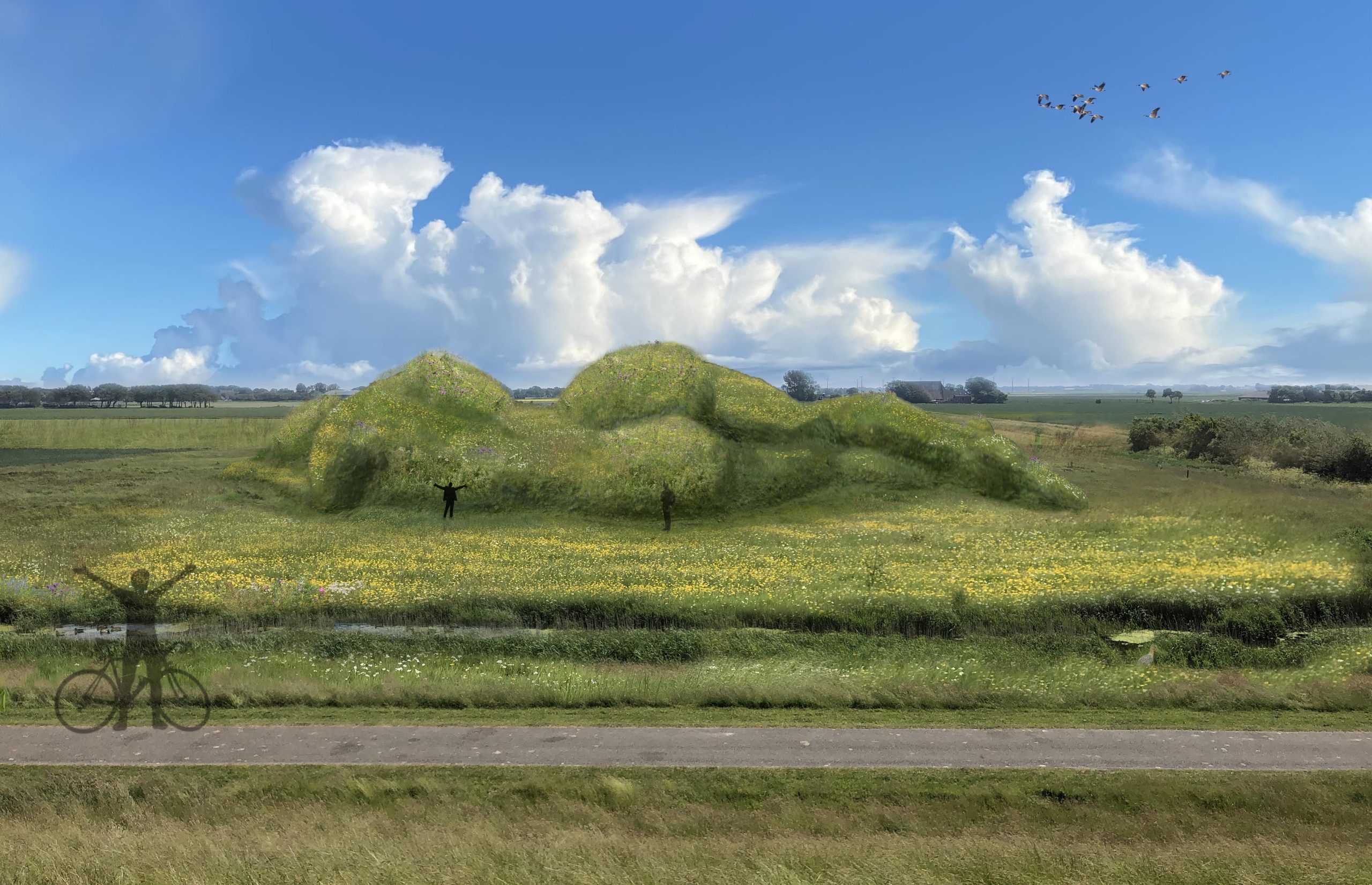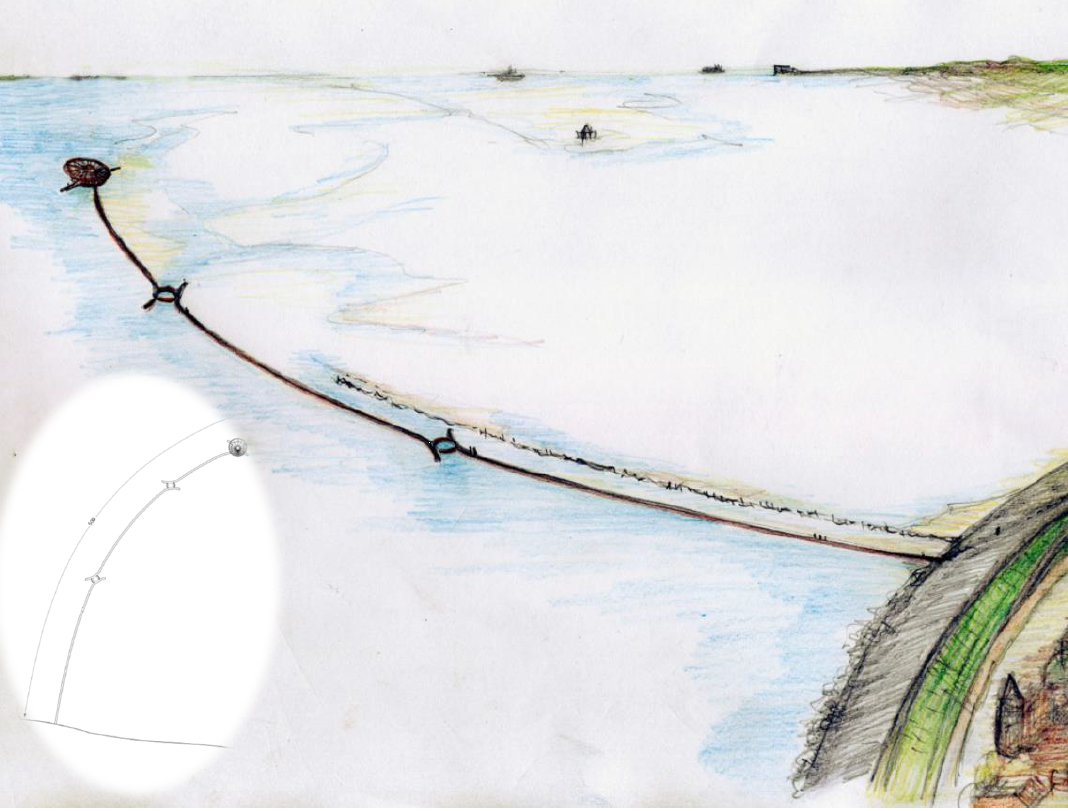The typical Dutch landscape with its new tight polders, dairy industry, potatoes and carrots inspired Nienke Brokke to do something with it. The artist wants to return the ‘voluptuous’ capriciousness of nature to this industrial agricultural landscape. The shapes of round buttocks in a literal ‘dike body’ seemed to her to be a nice contrast to the generally straight, tight dikes, while the monoculture of the vast plowed fields requires extra attention to biodiversity for birds and insects. Nienke sees a large, voluptuously shaped dike, overgrown with herbs and grasses. A breeding ground for insects.
The Dame
In the vast Frisian polder landscape, parallel to the austere Seedyk, a large reclining nude rises, covered with herbs and grasses.
It is large, +/- 60 meters long, locally 8 to 12 meters high at the hip and shoulders; like a voluptuously shaped dike. Her ‘fertile’ shapes refer to the arable land, to where food is grown. Associations with big buttocks, full breasts, milk and real butter are legitimate. Like a patroness, she lies there as a ‘dike body’ in the landscape. Just as the sea defense provides safety, it offers biodiversity in the arable land that is mainly dominated by monoculture. Dijk van een Wijf will also be a research project into how dikes in the Netherlands can be sown more sustainably and bio-diversely.
This research is taking place in collaboration with Van Hall Larenstein, Radboud University, the municipality of Waadhoeke, the Province of Fryslân, Bouwbedrijf Dijkstra Draisma and Cyril Liebrand of EurECO Ecological Consultancy, communities and nature organisations.
About the shape
The Dame lies stretched out on her side, turned in on herself. The shapes rise from the ground like a natural curve and the posture is at rest, relaxed. Her face is turned to the earth as if she is just rising from her sleep. The varying length of the herbs and grasses on the skin of the sculpture will influence the shape. It will make the contours softer or more pronounced. Recognition of the image is very important. The biodiverse vegetation is a maximum of 70 cm
About the location
Dijk van een Wijf is being realized near the village of Oosterbierum. The linear character of the polder and also the linear nature of the artificial sea defenses provide the dike with the right contrast and is therefore a perfect location. The large scale of the landscape does not allow the dike image to clash with its surroundings; instead of being a giantess, she takes on a human scale again in this landscape. For tourists visiting the Frisian North Coast, the location offers a nice resting point to admire from the Sedyk Dijk van een Wijf.
The visual work of artist Nienke Brokke always has a narrative element. The study of theater design at the Rietveld Academy has contributed to this.
As a ‘Gesamtkunstwerk’ in theatre, Nienke likes to work with multiple art disciplines that together form a whole. Because of that narrative side, Nienke Brokke designs educational projects in addition to land art and theater sets. She is good at connecting content with an art discipline.
The land art project ‘the Dame’ was her graduation project at the Rietveld Academy in 1997. We are working hard to actually realize the project in the next coming years.
More information: NienkeBrokke
Possible realisation: 2025
Location: municipality Waadhoeke

The Kromme Horne has it all: an abundance of light, vastness, serenity and spectacular panoramas. If you enter this curved pier at the village of Wierum, you will find yourself surrounded by hollows, salt marshes and plates, accompanied by the infinite light. At the end, like a ship on the horizon, you will spot a sculpture. Go on board and wander through the halls, whose windows will lead you to destinations unknown…
A curved 550-metre pier will run along the dike near the village of Wierum in the future. Visitors can walk across the pier, which runs mostly along the old pier and protects it from further decline. As they walk above the water and the slurry and along three panoramic views and dwellings, they experience the beauty of this unique landscape. The sculpture appears like a mirage, a ship with the bow turned toward the north: this is where the light is caught in a room – a room which provides protection from the wind and the sun and which entices you to linger or walk out onto the mud flats.
The Kromme Horne landscape object was created by and for people and in harmony with the natural world. The three ‘roundabouts with exits’ represent the spaces where the tide is caught. The leads to the creation of blowholes which – due to the currents – have had their appearance transformed over the decades. The landscape will be home to salt marshes and rift valleys, with mussel beds to be installed at one and vegetation planted at another, while the presence of the pier will also cause the existing salt marshes to grow again.
In an effort to revitalise their village, several of Wierum’s residents decided in 2016 to explore opportunities for new recreational facilities. Many different ideas were proposed and brainstorming sessions were held, including an exchange of ideas and various drawings. It was clear that a spatial element needed to be added to highlight Wierum’s visual qualities: the salt marshes, the mudflats, the endless dikes, the tranquillity, the tide, the colours, the light, the unique history, and the link to local shipping and hiking routes. The visual artist Ruud Reutelingsperger, a member of the Observatorium artist collective, became involved in the initiative, which ultimately resulted in this project.
More information: dorpwierum and observatorium for the great design!
Expected realisation date: unknown
Location: Wierum
